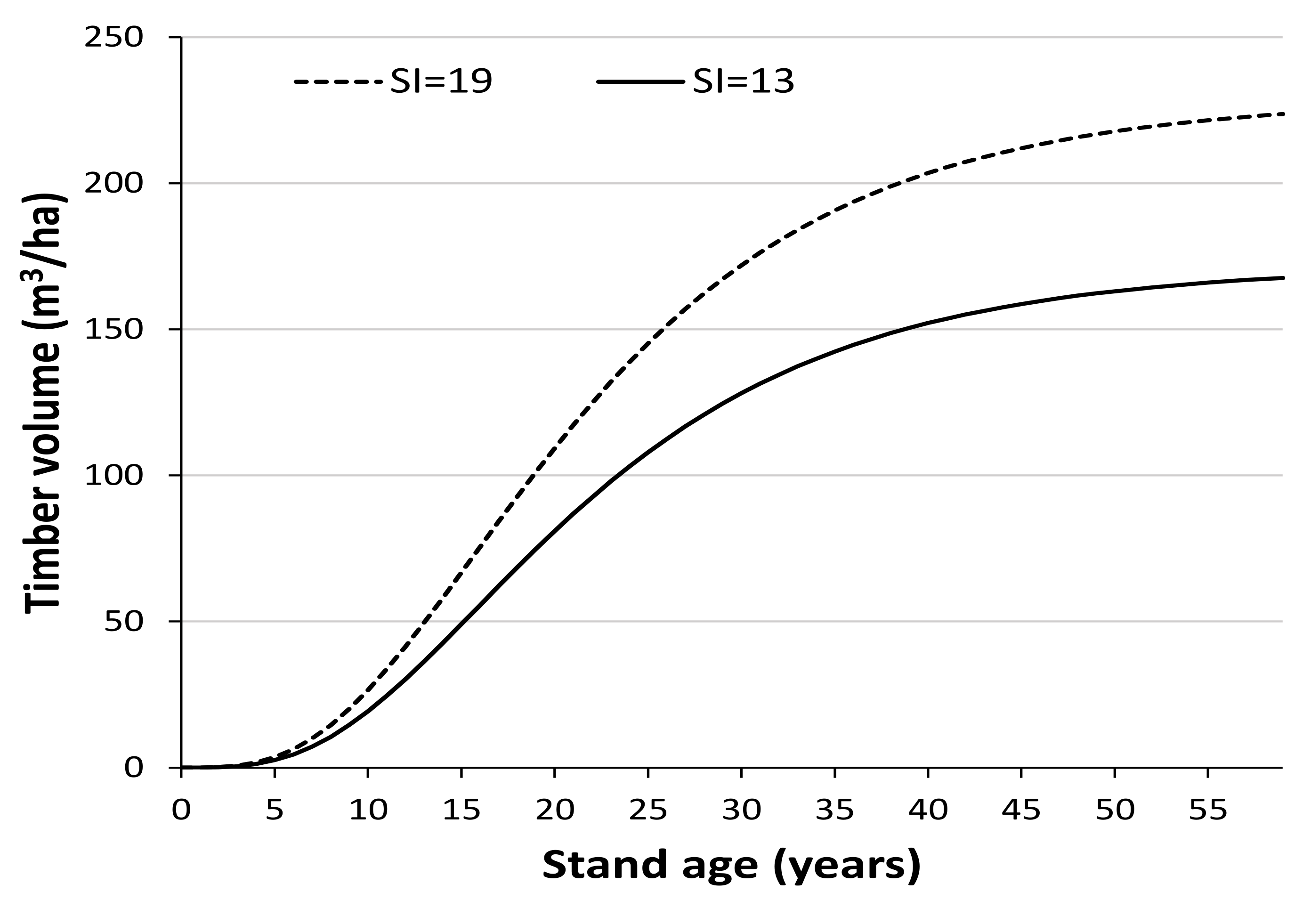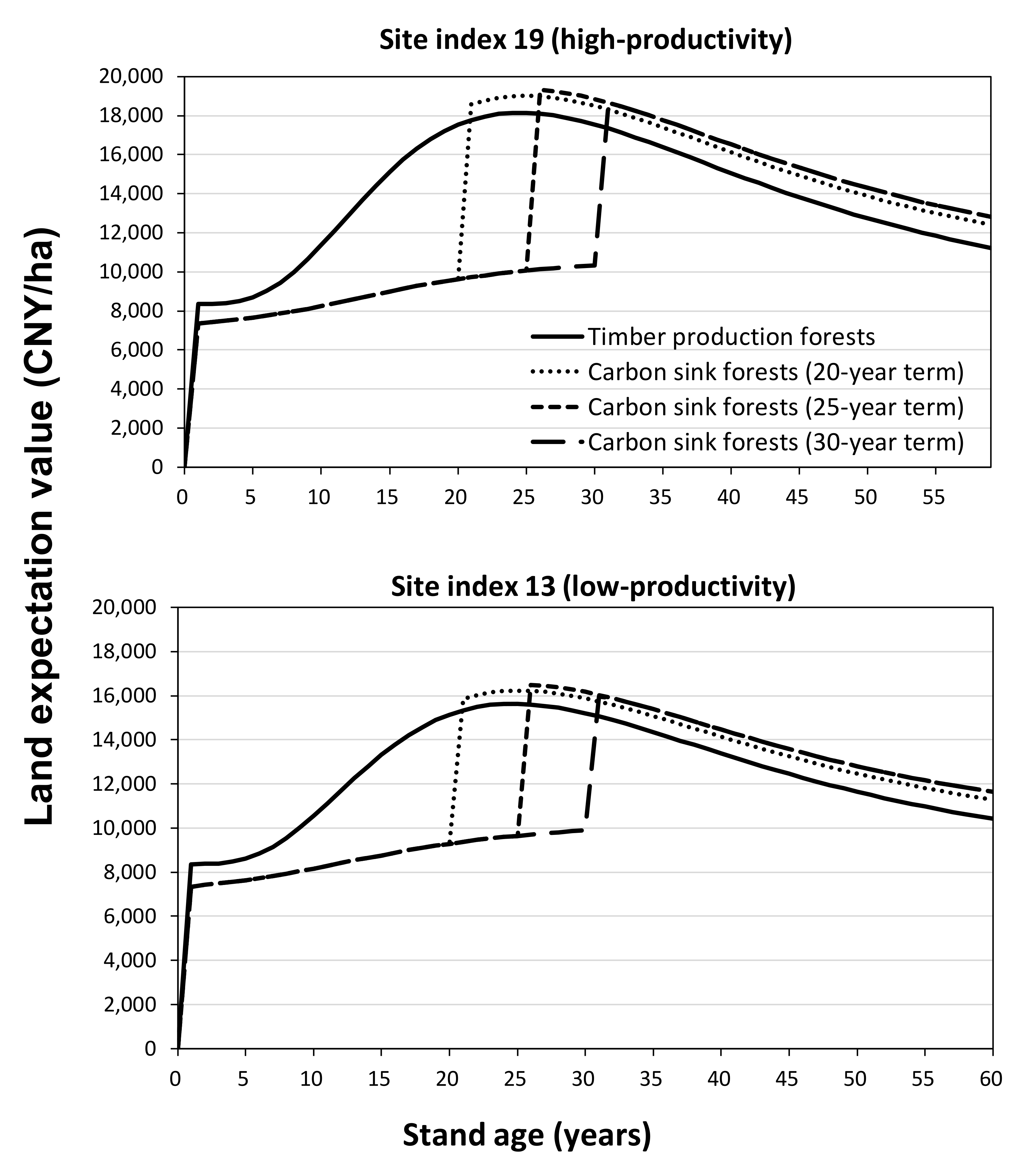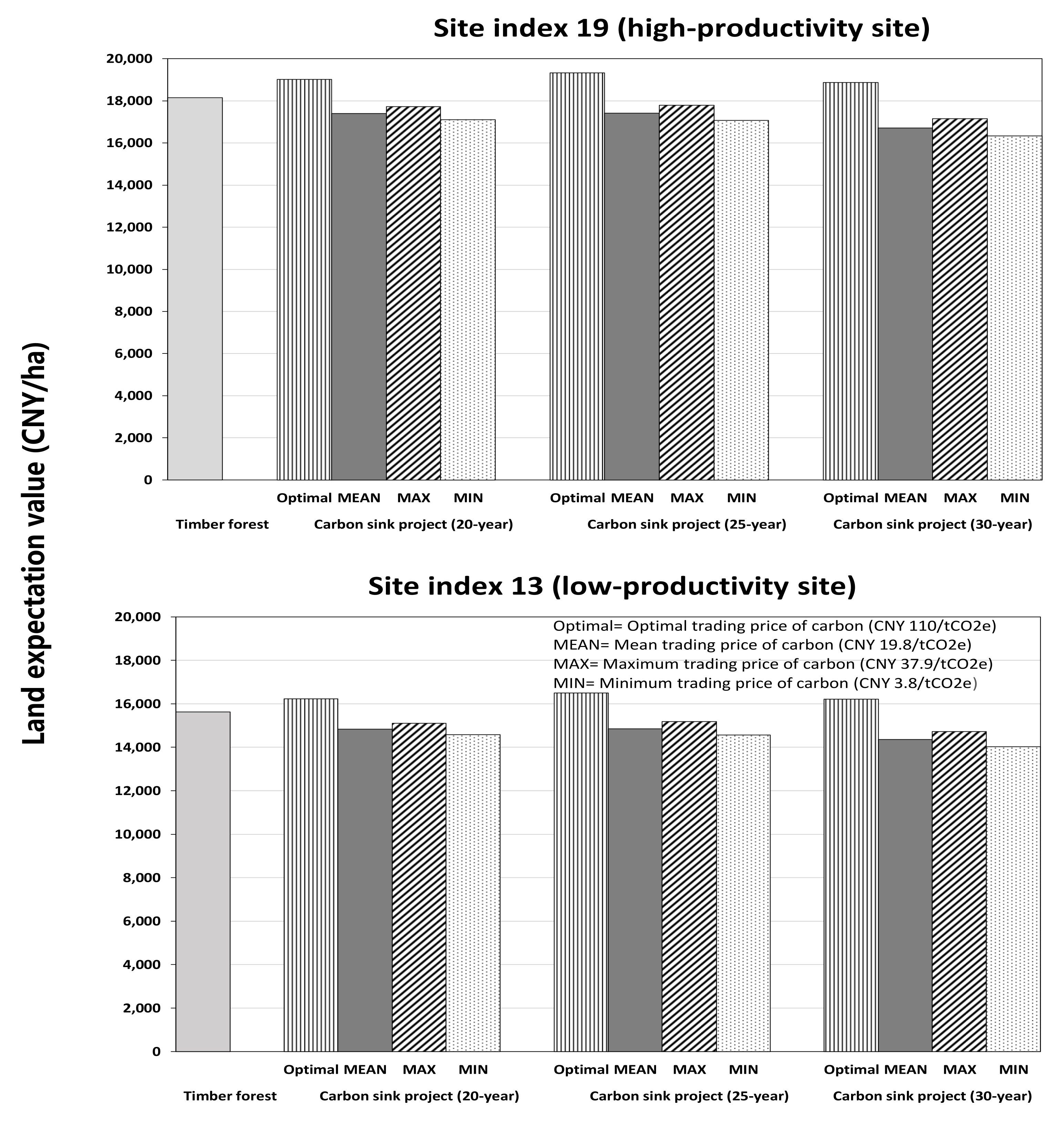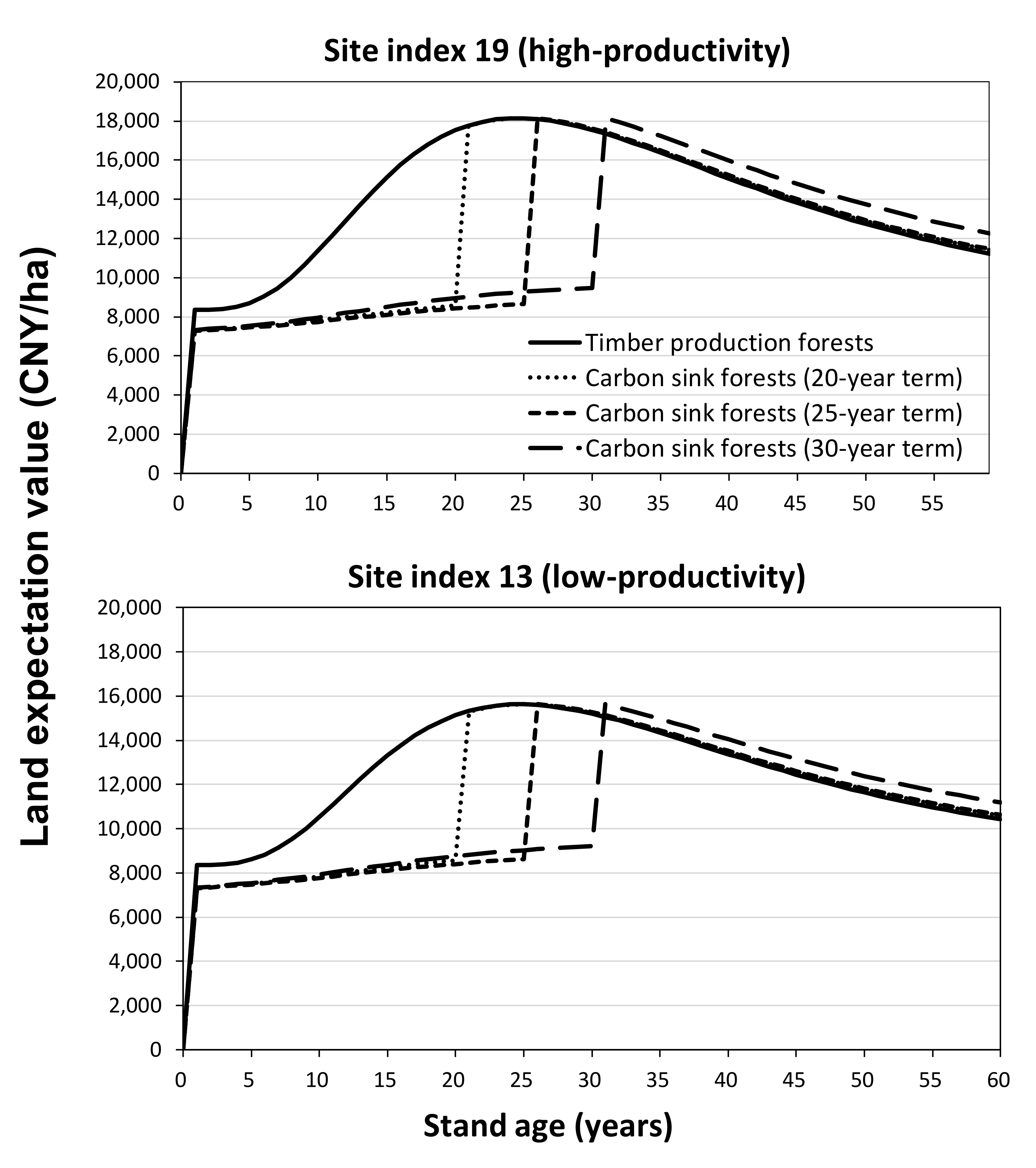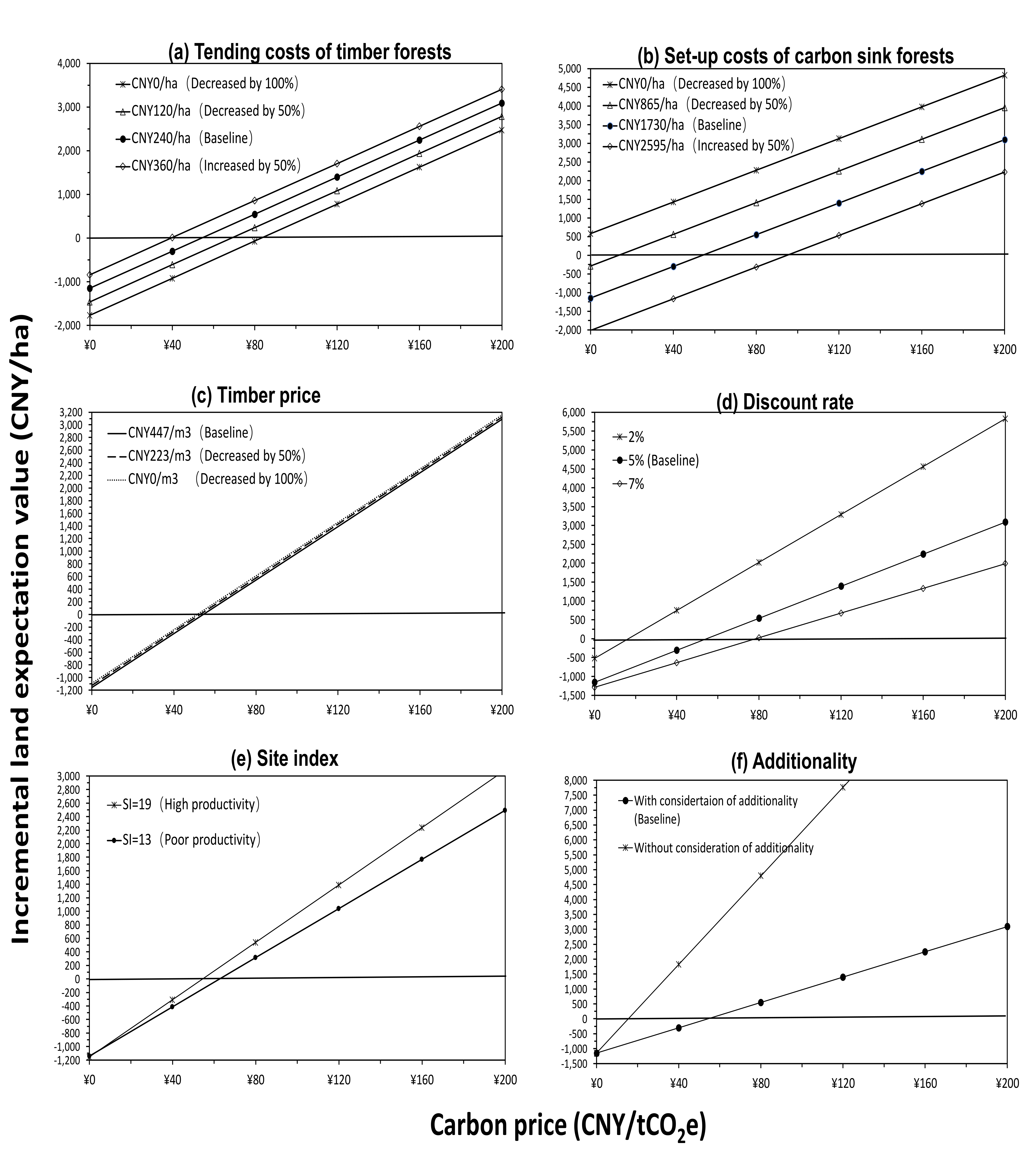1. Introduction
To mitigate the continued increases in carbon dioxide (CO
2) and other greenhouse gases (GHGs) in the atmosphere, many countries and regions worldwide have set carbon (C) emission targets and abatement strategies to reduce their GHGs emissions. In general, reducing CO
2 emissions from the combustion of fossil fuels while concurrently seeking ways to sequester C in long-term storage components are considered two of the most effective ways to lower the CO
2 level in the atmosphere [
1,
2]. Because trees and forests can take CO
2 and other GHGs from the atmosphere through photosynthesis and sequester it in biomass and soils, forests have played an important role in mitigating global climate deterioration [
3,
4].
In China, forest C sink plantation projects have been one of the main complementary climate change-mitigation strategies promoted by government authorities in recent years to achieve the goals of C emission peak before 2030 and C neutrality by 2060 [
5]. Forest C sink plantation projects comprise C sequestration and trading programs, in which forest farmers can sell C credits (which is a permit allowing the holder to emit CO
2 or other GHGs) to large emitters seeking to offset their CO
2 emissions [
6]. In this system, both parties are committed to forest management activities with the main goal of increasing forest C sequestration in designated lands within a specific contract period (e.g., 20–60 years in China) [
7]. During the contract period, forest farmers are not allowed to harvest trees and must follow a forest management plan to ensure that the increased C stock will be above and beyond the stock associated with current practices; in addition, farmers are responsible for the costs (i.e., C sink measurement, monitoring, and verification) associated with the C credits received from the projects [
8]. On the other hand, the party seeking to lower its C emissions to within a specific limit purchases C credits from forest farmers who participate in forest C sink plantation projects in installments or at the expiration of the project and uses the C credits to offset the C emissions it generates in its production processes. Forest C sinks have become an important part of the C emission trading market and are generally considered a market-based eco-compensation mechanism in China [
9].
A successful forest C sink project requires (1) that the financial benefit offered to induce potential forest C sink suppliers (e.g., private forest farmers, tree growers, and forestry cooperatives) to establish C sink forests must not be less than the cost of participation in the forest C sink projects and, more importantly, (2) that the net income from managing a C sink forest should be greater than the net income from operating a traditional timber production forest [
10]. Specifically, only when the net income generated from managing a C sink forest is greater than the net income from managing a traditional timber production forest do forest farmers have the economic incentive to participate in forest C sink projects. Therefore, an economic model that quantifies the related benefits and costs from managing timber production forests and C sink forests would provide important guidance to forest farmers for making optimal forest management decisions.
In forestry investment analysis, there are several criteria for assessing the economic value of a growing forest and the optimal rotation age, including maximum sustainable yield, maximum annual average net income, single-period net present value, and land expectation value (LEV) [
11]. LEV refers to the sum of the net present values of the income from an infinite number of rotations of continuous investment, starting from a state of bare land or a new forest on land that was not previously forested (e.g., row crops or pastureland). LEV is a theoretical estimate of the value of a forestland, which reflects the present value of all cash flows produced by an infinite series of harvests at a given rotation length under an assumed management regime [
11]. In previous studies in China, the classic Faustmann model [
12] has been frequently applied to assess multi-objective forest management from pure timber production to C sequestration benefits, including the use of Faustmann–Hartman [
13] model in the economic analysis framework (see [
14,
15,
16,
17,
18,
19,
20,
21,
22]). While these studies have provided valuable contributions with respect to understanding the effects of changes in C trading prices on the optimal rotation age, LEVs, and the supply of forest C sinks in China, the application of the classic Faustmann formula, which assumes that stumpage prices, stand volume, regeneration cost, and interest rate remain unchanged rotation after rotation, may not truly reflect the actual forest management regime, in which the majority of forest farmers are small-scale tree growers. Moreover, given that most of the forest C sink projects in China at present are in contract terms, and neither thinning nor harvesting of trees is allowed during the contract period, there is a need to specifically include the timber harvesting restrictions in the economic model for a better estimate of the LEVs of forest C sink projects. Last, while forest farmers who participate in forest C sink projects may benefit from selling the C credits on their forestlands over the use of their forestlands as timber production forests, they also bear the additional setup costs of the projects (e.g., C sink measurement, monitoring, and verification costs), which may be a disincentive to forest farmers if the enrollment costs are too high [
23]. These three aspects have not been considered and discussed in previous studies.
To address the knowledge gaps that have been previously mentioned, the purpose of this paper was to investigate (at the stand level) the potential financial benefits that forest farmers (especially small-scale tree growers with only one stand) can realize when enrolling in a larch (
Larix kaempferi (Lamb.) Car.) C sink plantation project in the northwestern Chinese province of Gansu by using the generalized Faustmann model developed by Chang [
24,
25]. A decision matrix was developed to help forest farmers justify participation in forest C sink plantation projects when comparing the LEVs of a timber production forest and a C sink forest under different biophysical and economic conditions (e.g., site conditions, C sink project periods, and C trading prices). The results of this study can help policymakers and forest managers formulate optimal eco-compensation strategies for enrollment in forest-based C sequestration programs.
2. Decision Model
2.1. The Generalized Faustmann Model
Under the classic Faustmann model, the LEV is expressed as
or
where
represents the LEV per hectare of timber crop at age
t,
is the unit stumpage price,
represents the stand volume (m
3) at age
t,
is the average regeneration cost, and
is the discount rate.
Under the classic Faustmann model, the parameters in Equation (1) remain the same from harvest to harvest. However, in the real timberland market, this stability is unlikely, especially for the management of nonindustrial forestlands. For example, after each harvest, the landowner may replant a new timber crop and encounter different stumpage prices, forest growth, regeneration costs, and discount rates. Thus, the optimal harvest is also expected to fluctuate from timber crop to timber crop. Moreover, forest farmers may convert forestland to other land uses, such as fruit orchards or agricultural crops, or even develop real estate. To make the classic Faustmann formula more realistically reflect the forestland value, Chang [
24] first developed the generalized Faustmann formula, which allows the parameters in Equation (1) to change from rotation to rotation and accommodates land-use changes by permitting different types of crops, such as timber, fruit, or grain, for different harvest periods. Therefore, the LEV under the generalized Faustmann formula can be expressed as
Equation (3) can also be expressed as
in a dynamic programming format with the classical recursive relation, where
represents the LEV at the beginning of the first rotation, and
LEV2 is the LEV at the beginning of the second rotation.
represents the stumpage price of the
th timber crop at age
,
represents the stand volume at age
,
represents the annual net income from miscellaneous nontimber sources for age
(such as from a C sink),
represents the regeneration cost of the
th timber crop, and
represents the discount rate for the
th timber crop.
Theoretically, Equation (3) indicates that the land expectation value at the beginning of the first timber crop (
LEV1) includes the summation of the net present value at the beginning of the first timber crop and the land expectation value at the beginning of the second timber crop (and so on). Alternatively,
LEV2 represents a single value that incorporates all of the optimal harvest age decisions for future timber crops, with the value obtainable from the forestland transaction market and exogenously determinable [
24,
25]. The Hartman [
13] Model, which considers the net annual income from other miscellaneous sources, can be treated as a special case of Equations (3) or (4).
Empirically, the generalized Faustmann model has made the management of forestlands (including even-aged natural stands, even-aged plantations, and uneven-aged stands) more applicable in practice and offers much broader and richer interpretations relative to the classic Faustmann model; additionally, it has been employed to assess the effects of potential C benefits on optimal rotation ages of even and uneven-aged forest stands in the southern United States (e.g., [
26,
27,
28]). Thus, the LEV derived from the generalized Faustmann model can provide more valuable information to help forest farmers in evaluating different management options of their forestlands.
2.2. Land Expectation Values for Timber Production Forests and C Sink Forests
In this study, we assumed that forest farmers face two alternative options for the management of their forestlands: (1) to manage their forestlands for timber production (considered the base case) or (2) to participate in a forest C sink plantation project with a minimum commitment of a 20-year contract term for the case in China. Thus, the reference year for evaluation is at the time of planting. To evaluate the economic attractiveness of these two forest management options, Equation (4) is slightly expanded and modified to costs and income specific to these two alternatives. Specifically, the maximum LEV of timber production forests can be expressed as
In Equation (5), denotes the LEV per hectare of timber forestland for optimal rotation age under the generalized Faustmann model, is the harvested log price of trees at age , represents the stand volume at age , is the expected merchantable roundwood (sawlog) yield rate of a stand, is the harvesting and transportation costs, is the annual tending cost per hectare at stand age , represents the regeneration cost per hectare of forestland (including site preparation and planting costs), and represents the LEV at the beginning of the second timber crop (and so on).
Depending on the contract terms and the installment plans for forest C sink projects, the optimal harvest age and corresponding maximum LEV for C sink forestland should be carefully considered. Specifically, when the optimal rotation of timber age
is equal to or less than the length of the C sequestration contract
n*k (with
n being the total number of installment payments and
k being the length of each payment period), the forest farmers have to finish the C sequestration contract first, and then, they can harvest the timber after the expiration of the C sink projects to realize the maximum revenue for the management of their forestlands (of course, forest farmers can also decide not to harvest timber and to keep their C sink forests intact after the expiration of the project. However, given the fact that forest farmers do not have an obligation to maintain the C stock and will not receive any payments for the additional C credits generated on their forestlands after the expiration of the project for most C sink projects in China, there is no penalty for timber harvesting after the contract. Thus, we assumed that a rational economic agent should consider harvesting trees to acquire the timber revenue, after which they can consider whether to enroll in a new forest C sink project to gain the additional revenue from the newly planted C sink forests). In this case, the optimal harvest age for C sink forests will be the year after the expiration of the C sink projects (i.e.,
, and the maximum generalized LEV of C sink forestland can be written as
If the optimal rotation of the timber age is longer than the length of the C sink project, the forest farmers can finish the C sink contract, after which they can wait until timber age
to harvest the trees and start the next timber rotation. In this case, the maximum LEV of the C sink forests is
In Equations (6) and (7), is the price per metric ton of C dioxide equivalent (tCO2e), is the amount of C sequestered for each period of installment payments, is the total number of installment payments for C credits, is the setup cost of the forest C sink project (which mainly includes project preparation, C sink measurement, monitoring, and verification costs), and denotes the LEV at the beginning of the second rotation, which may or may not involve a C sink project. In addition, a C leakage factor (1 – α) is included in the third term on the right-hand side of Equations (6) and (7) to consider the potential C leakage effect (i.e., penalty, which refers to the process by which the C stored in living biomass is released to the atmosphere at the time of timber harvest) if the remaining treetops and slash are used as fuelwood in rural communities at the time of harvest.
In this study, we assumed that the LEV of the future C sink forest (
) will be identical to the LEV of the future timber production forest (
) due to the limited available transaction data for the C sink forests in the study area. This assumption allows us to specifically examine the effects that we can attribute to the potential benefits derived from the first plantation crop either used for timber production only or as a C sink. The value for LEV of future timber production forest was obtained from the timberland transactions of our study region (i.e., Gansu province) from the Chinese Forestland Trading Platform [
29].
The economic attractiveness of participating in a forest C sink project can be evaluated by comparing the maximum LEVs at the optimal harvest age for the timber production forests and C sink forests. Taking timber production forest as an example, the optimal value of is calculated numerically by substituting the value of t1 from 5 to 60 years in Equation (5) until a maximum LEV is found. Specifically, the net financial benefits of program enrollment can be estimated by subtracting the LEV of timber production forests from the LEV of C sink forests to obtain the incremental LEV. If the incremental LEV is greater than zero, which means that the LEV of C sink forests outweighs the LEV of timber production forests, then participating in a C sink project can be supported on economic grounds. Otherwise, forest farmers should continue to manage their forestlands for timber production.
2.3. Eco-Compensation Standards for the C Sink Plantation Projects
The decision model developed in the previous section will help us further explore the government’s role in subsidizing forest C sink plantation projects. In China, the term “eco-compensation” is generally used to refer to a combination of ecological compensation and payments for ecological goods and services [
30]. Specifically, if business entities’ willingness-to-pay for C credits from a C sink project is lower than the willingness-to-accept of a forest farmer willing to sell C credits, the forest C sink project cannot be realized. However, from a policymaker’s perspective, the government can support the emerging ecosystem market, such as forest C sink projects via eco-compensation. The role of the governments can also shift from the massive participation to a facilitator via market-based emission trading mechanisms. The subsidy for C sink projects to forest farmers can be set as the difference between the willingness-to-pay from those who need to purchase C credits and the willingness-to-accept from those who are willing to sell C credits. In forest C sink projects, buyers of C credits generally refer to the observed C trading price in markets to set the willingness-to-pay for C sink projects. Thus, we need to determine the minimum price that C credit sellers are willing to accept for each ton of C credit supply, which can be expressed as follows:
Solving for the minimum C credit price () required by sellers requires a solution for the C credit price in Equation (8); then, the optimal subsidy that the government should provide to incentivize forest farmers for program enrollment is the difference between the required minimum C credit price and the observed C trading price in markets (.
3. Empirical Analysis
In this study, our study site for the C sink plantation projects in northwestern China was determined based on the following information. Larch, which is a common and fast-growing plantation species in the Xiao-Long-Shan forest district of Gansu Province, was used as the sample tree species for the simulation [
31,
32]. Furthermore, we assumed that forest farmers have the option to participate in forest C sink projects under three contract terms: 20 years, 25 years, or 30 years, covering most of the terms of forest C sink projects existing in China [
10,
23]. A tree growth and yield model developed by Jin et al. [
33] was used to project the stand volume of even-aged larch stands under the following two site productivity levels: high (with site index (SI) 19 m at a breast height age of 18 years) and low (SI 13 m) productivity, which is presented in
Figure 1 (see
Appendix A for the functions used for tree growth and yield projections).
The measurement of forest C stock on site is an important basis for correctly assessing the LEV of C sink forests. In this paper, a C sink model was established following the Guidelines of C Sink Plantation Projects issued by the National Forestry and Grassland Administration of China [
8]. In the biophysical model, the aboveground biomass, belowground biomass, dead wood, litter, and soil organic C stocks are considered the forest C pool (see
Appendix B for the measurement of each C stock). Thus, a Larch C sink forest can sequester around 242 tons of CO
2e at the tree age of 30 years on high-productivity sites in our study area. To ensure that there is additional C sequestered from the C sink plantation projects in comparison to the baseline scenario of timber production forests, the number of C credits earned from C sink projects is expressed as the difference between the amount of C sequestered from C sink forests and the baseline amount of C sequestered from timber production forests [
8]. Without deducting the baseline C sink from timber production forests in the analysis (i.e., the issue of additionality), the predicted C credits available for trading from C sink projects would be overestimated and therefore could have a large effect on financial returns to forest farmers [
23,
34]. Moreover, given that forest management plans for C sink forests are similar to (or mimic) those of unmanaged natural forests in China to ensure that the increased C storage will exceed that associated with current practices in forestlands, the C sequestration ratio of a C sink forest to a baseline timber production forest in our study region was set as 1.40, following the suggestion from Guan et al. [
32].
Table 1 presents the related numerical values of the economic parameters used in the generalized Faustmann model for simulation. Because the LEVs of C sink forests may fluctuate significantly due to C market dynamics, we conducted a sensitivity analysis with four C trading price scenarios (i.e., theoretically optimal, observed minimum, average, and maximum market prices) from the Shenzhen Emissions Exchange [
35], the most vibrant emissions exchange market in China to investigate their effects on LEVs. The optimal C price, which is the theoretical C trading price that Chinese business entities are willing to pay for forest C credits with consideration of the current global C emission level, population, and China’s disposable personal income and its corporate social responsibility, was adopted from Long et al. [
36]. Moreover, we assumed that the payment for C credits occurs every 5 years, which more realistically reflects the current situation in practice. Finally, a comparative static (sensitivity) analysis was conducted to investigate the impacts of important parameters that changed in the decision model (including discount rates, setup costs of a C sink project, tending costs, site conditions, and future LEVs) on the minimum willingness-to-accept for the C trading price and incremental net present values (NPVs) necessary for a forest farmer to participate in a C sink project.
5. Discussion
In this study, the generalized Faustmann model was applied as a decision-making tool to help private forest farmers in the northwestern Chinese province of Gansu evaluate the financial attractiveness of participating in a larch C sink plantation project relative to the traditional land-use goal of timber production. A number of important findings and policy implications was found regarding the supply of C sink forests and the optimal eco-compensation for program enrollment in the region. First, the results of our case study indicated that under the current C price rates in the market (including the maximum, mean, and minimum C prices), enrolling in a larch C sink project with any contract terms and site conditions could not be supported on economic grounds. These results suggest that the current C trading prices in China may still be too low; therefore, a subsidy or eco-compensation is required from the government to encourage forest farmers to enroll in these programs. However, the results of our case study also indicated that a forest farmers would have sufficient economic incentives and motivation to spontaneously participate in a forest C sink project with a 20-, 25-, or 30-year term under any site conditions when the C price is at the theoretically optimal level of CNY 110/tCO
2e (equivalent to USD 17/tCO
2e). As a result, the Chinese central or local governments could act as catalysts for the financial protection of forest C sink projects by continuously supporting the development of C exchange markets. For example, once the C price rates in China are similar to the global price levels of USD 40–80/tCO
2e (equivalent to CNY 260–520/tCO
2e) in 2020, as recommended by the High-Level Commission on C Prices [
42], it is highly possible that participating in a forest C sink project could generate greater financial benefits than the timber production forests. Moreover, it may be socially optimal never to harvest the trees, as indicated by Hartman [
13], if the values of standing forests (e.g., C sequestration, forest recreation, etc.) are high enough.
The results of our analysis also revealed that forest farmers who enroll in a 25-year term larch C sink plantation project would generate more revenue (or less loss) on their forestlands compared with the other two project terms investigated in this study. These results indicate that there exists an optimal contract term of C sink projects, and forest farmers could refer to the optimal economic rotation age of the selected tree species as a basis to choose a contract term for profit maximization. These findings also imply that each forest C sink project should be evaluated independently according to its biophysical (e.g., tree species, site conditions, C stock) and economic (e.g., C price rates, opportunity costs of original land-use goal) conditions. Thus, a “one-size-fits-all” policy on forest C sink-related issues may not be the best policy or preferred strategy for policy makers and forest managers. This aspect is vital, especially when governments give financial support in the form of subsidies or compensation to participating farmers.
The results of our analysis with consideration of C leakage penalty at the time of harvest (shown in
Table 2) reveal that the potential C leakage penalty could exert the greatest effect on incremental benefits under the highest C price scenario in our analysis. For example, when comparing the results in
Table 2 with the results evaluated under the scenario of no penalty for C leakage at harvest (see
Table A3 in
Appendix B), the incremental benefits of participating in a forest C sink project would be reduced by less than 3% under the minimum C trading price of CNY 3.8/tCO
2e to more than 30% under the optimal C price rate of CNY 110/tCO
2e. This result indicates that the issue of a C leakage penalty may discourage forest farmers from program enrollment if harvesting trees after the expiration of the contract term is an option and if the C trading prices would be increasing in the future. While the Chinese government does not currently charge a penalty on C leakage at the time of harvest, many studies tend to consider C leakage penalties that are incurred at tree harvest (e.g., [
43]) and examine the leakage effects on LEV from society’s perspective. Therefore, policymakers should also design a better mechanism to incentivize forest farmers voluntary participation in forest C sink projects.
The potential net benefits of enrolling in a larch C sink plantation project compared with managing the forestland for timber production in the study region are thoroughly discussed and are presented in our decision matrix in
Table 2 in order to guide policymakers toward the optimal eco-compensation of forest C sink projects. The minimum required C credit prices presented in our study also provide useful information for forest farmers in the evaluation of various scenarios for program participation. However, it should also be acknowledged that there is only one C price in the marketplace (i.e., the Law of One Price prevails), which would make it less likely and more difficult for forest farmers with poor-productivity sites to participate in forest C sink projects. Thus, caution must be taken when interpreting our results.
Finally, several important results emerged when examining the impacts of changes in parameters in the decision model on the net benefits of forest C sink projects. Specifically, from the benefit side, our results indicate that increasing the available C offset credits for trading has a large effect on financial returns to forest farmers (see
Figure 5f), a scenario without consideration of additionality). From the cost side, reducing the setup costs of forest C sink projects could also significantly increase the net income from managing C sink forests (see
Figure 5b). This information provides valuable insights for governments regarding the development and improvement of the forest C sink market, such as by building managerial capacity, establishing forest C sink cooperatives, and disclosing project information more transparently to reduce transaction costs. Moreover, it is important to note that a 100% reduction in tending costs of timber forests or initial setup costs of C forests is unrealistic in practice. Thus, our sensitivity analysis results may imply that the Chinese central government may need to intervene and pay for the C sequestered under the business-as-usual scenario (i.e., the land-use goal of timber production) and furthermore consider subsidizing the initial setup costs of forest C sink projects through public funding to incentivize the participation in forest C sink projects by forest farmers. As shown in
Figure 5b, forest farmers would have enough economic incentives (with a gain of CNY 130/ha) to participate in a forest C sink project at the current average C price of CNY 19.8/tCO
2e if the government could subsidize 50% of the setup costs of C sink projects. We consider this type of cost-sharing mechanism a more viable policy alternative for participation in forest C sink projects. Finally, we also propose that the government can conduct related measures to stabilize the price of C market. For instance, compensating forest farmers when C price in the market is below the minimum required (threshold) C prices as shown in
Table 3 and adopting a lower discount rate (e.g., 1% or 2%) to increase forest asset values for private forest enterprises, as suggested by Sauter and Mußhoff [
44], could significantly increase forest farmers’ interests of participation in such project. All of these measures could also help the Chinese government reach the C neutrality goals in 2060.
Although this study was conducted from the perspective of private forest farmers and specifically focused on small-scale tree growers who have only one stand to evaluate the potential financial benefits of the conversion of land from timber production forests to C sink forests, the analytical framework and economic model could be applied to other alternative land-use options. A further extension of the research would be an assessment of the Grain for Green program in China (The Grain for Green Project is a nationwide program in China in which the central government pays farmers to revert sloping or marginal farmland to forests or grass and is the largest ecological restoration and rural development program in the world. The objective of the program is to improve the ecological conditions and the livelihood of millions of people in rural China. See Delang and Yuan [
45] for a review of the program). Future research directions include investigating the optimal subsidy or eco-compensation for farmers reverting sloping or marginal farmland to forests or grass, where timber harvesting or ranching is not allowed indefinitely. Analysis of factors influencing forest farmer’s decision-making behavior for program enrollment and the issue of available C offset credits for trading (i.e., additionality) on existing managed forestlands also warrant future research.
